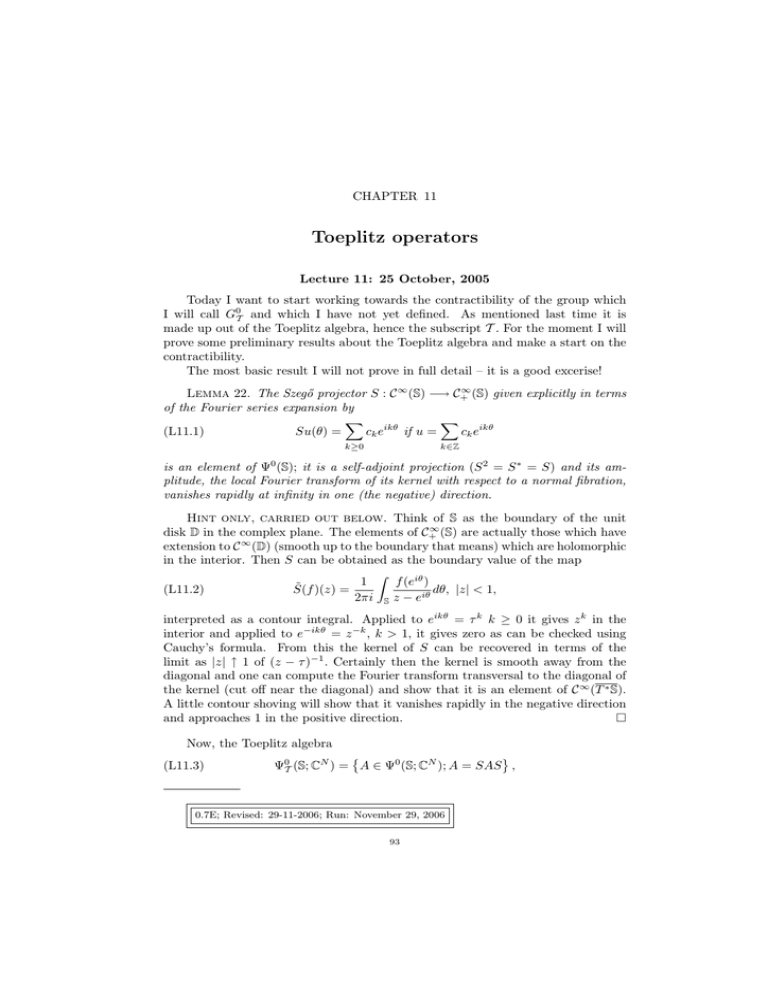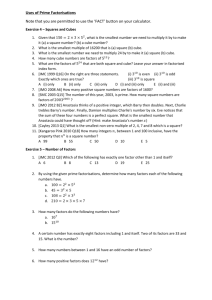Toeplitz operators
advertisement

CHAPTER 11
Toeplitz operators
Lecture 11: 25 October, 2005
Today I want to start working towards the contractibility of the group which
I will call G0T and which I have not yet defined. As mentioned last time it is
made up out of the Toeplitz algebra, hence the subscript T . For the moment I will
prove some preliminary results about the Toeplitz algebra and make a start on the
contractibility.
The most basic result I will not prove in full detail – it is a good excerise!
∞
Lemma 22. The Szegő projector S : C ∞ (S) −→ C+
(S) given explicitly in terms
of the Fourier series expansion by
X
X
(L11.1)
Su(θ) =
ck eikθ if u =
ck eikθ
k≥0
k∈Z
0
is an element of Ψ (S); it is a self-adjoint projection (S 2 = S ∗ = S) and its amplitude, the local Fourier transform of its kernel with respect to a normal fibration,
vanishes rapidly at infinity in one (the negative) direction.
Hint only, carried out below. Think of S as the boundary of the unit
∞
disk D in the complex plane. The elements of C+
(S) are actually those which have
∞
extension to C (D) (smooth up to the boundary that means) which are holomorphic
in the interior. Then S can be obtained as the boundary value of the map
Z
f (eiθ )
1
dθ, |z| < 1,
(L11.2)
S̃(f )(z) =
2πi S z − eiθ
interpreted as a contour integral. Applied to eikθ = τ k k ≥ 0 it gives z k in the
interior and applied to e−ikθ = z −k , k > 1, it gives zero as can be checked using
Cauchy’s formula. From this the kernel of S can be recovered in terms of the
limit as |z| ↑ 1 of (z − τ )−1 . Certainly then the kernel is smooth away from the
diagonal and one can compute the Fourier transform transversal to the diagonal of
the kernel (cut off near the diagonal) and show that it is an element of C ∞ (T ∗ S).
A little contour shoving will show that it vanishes rapidly in the negative direction
and approaches 1 in the positive direction.
Now, the Toeplitz algebra
(L11.3)
Ψ0T (S; CN ) = A ∈ Ψ0 (S; CN ); A = SAS ,
0.7E; Revised: 29-11-2006; Run: November 29, 2006
93
94
11. TOEPLITZ OPERATORS
∞
(S; CN ), is topologically simpler
which is regarded as an algebra of operators on C+
than the whole of the algebra, as we shall see. I will proceed to prove some results
for this and the whole algebra, leaving the ‘stabilization’ to next time.
First is the simplest basic result leading to the definition of the (analytic)
families index of a family of elliptic pseudodifferential operators. I will do this for
the circle but the proof will later be shown to extend almost unchanged to a general
manifold. The circle is much simpler than the general case, at the moment, because
we have a sequence of smoothing projections
X
X
(L11.4)
πr : C ∞ (S) ∋ u =
ck eikθ 7−→ πr u =
ck eikθ ∈ C ∞ (S).
k
|k|≤r
We extend these to act componentwise on vector-valued functions. The crucial
property that these projections have is that
(L11.5)
A ∈ Ψ−∞ (S; CN ) =⇒ Aπr → A in Ψ−∞ (S; CN ).
Proposition 24. Suppose that A : X −→ Ψ0 (S; CN ) is a smooth family of
elliptic pseudodifferential operators, parameterized by a compact manifold X, then
there exists a smooth family B : X −→ Ψ−∞ (S; CN ) such that (A(x) + B(x))−1 ∈
Ψ0 (S; CN ) exists for each x ∈ X, if and only if for large enough r the
(L11.6)
Fr (x) = null((Id −πr )A∗ (x)) ∈ C ∞ (S; CN )
form a smooth vector bundle over X which is bundle-isomorphic to a trivial bundle
of dimension (2r + 1)N.
Proof. First we show that for r large enough, the Fr (x) do indeed form a
smooth vector bundle over X. Since A(x) is an elliptic family, there is a smooth
family Q : X −→ Ψ0 (S; CN ) of parametrices for the A(x), so
(L11.7)
Q(x)A(x) = Id −R(x), R ∈ C ∞ (X; Ψ−∞ (S; CN )).
Composing on the right with Id −πr we get
(L11.8)
Q(x)A(x)(Id −πr ) = (Id −Rr′ (x))(Id −πr ), Rr′ (x) = R(x)(Id −πr ),
where the fact that (Id −πr )(Id −πr ) = (Id −πr ) has been used. Since R(x)πr →
R(x) uniformly as a family of smoothing operators (i.e. in the C ∞ toplogy) we
know that for large enough r the inverse
(L11.9)
(Id −Rr′ (x))−1 = Id −Sr (x), Sr ∈ C ∞ (X; Ψ−∞ (S; CN )
exists. Composing on the left with the inverse and then with the operator Id −πr
and setting Q′ (x) = (Id −πr )(Id −Sr (x))Q(x) we find that
(L11.10)
Q′ (x)A′r (x) = Id −πr , A′r (x) = A(x) − A(x)πr .
From this it follows that the null space of A′r is precisely
(L11.11)
null(A(x)(Id −πr )) = null(Id −πr )
the span of the Fourier terms with wavenumber |k| ≤ r. This is a trivial vector
bundle over X of dimension (2r + 1)N. Certainly, the left in (L11.11) contains the
right and if (Id −πr )u = u then (L11.10) shows that A′r (x)u 6= 0.
It also follows from (L11.10) that the Fr (x) form a smooth vector bundle over
X. To see this, recall that we know the (numerical) index of A(x) to be a homotopy
LECTURE 11: 25 OCTOBER, 2005
95
invariant. In particular it is a fixed integer for all x (well, in each component of X)
for A′r (x). Since
(L11.12)
ind(A′r (x)) = (2r + 1)N − dim(Fr (x))
is locally constant, the Fr (x) have locally constant dimensions and this is enough to
guarantee that they vary smoothly with x ∈ X. In fact Q′ (x) has range the same as
Id −πr and hence has null space which is of constant dimension and A′r (x)Q′ (x) =
Id −G(x) has null space which is a smooth bundle isomorphic to Fr .
Thus we have succeeded in ‘stabilizing’ the null spaces to a bundle and the
complements to the range to a bundle by modifying A(x) by a smoothing operator
to A′r (x) = A(x) − A(x)πr . The ‘families index of A’ is the formal difference of the
null bundle and complement to the range
(L11.13)
[(A′r (x) ⊖ Fr ] ∈ K 0 (X)
where for the moment I have not defined either the left or right sides of this inclusion.
Now, we can prove one direction of the Proposition. If for large r there is an
isomorphism to a trivial bundle over dimension (2r +1)N then we can interpret this
as an isomorphism of Fr to null(A′r (x)) and in this sense it is given by a family of
smoothing operators, which we can denote by Br′ (x). Clearly A′r (x) + Br′ (x) is then
a family of invertible operators, differing from the original family by smoothing
operators as anticipated.
Conversely, suppose that such an invertible perturbation exists so A(x) + B(x)
is invertible for all x ∈ X. Since B(x)πr → B(x) uniformly in the C ∞ topology, it
follows that A(x) + B(x)πr is invertible for r large enough. Since this is equal to
(L11.14)
A′r (x) + Br (x), Br (x) = (A(x) + B(x))πr
where A′r (x) = A(x)(Id −πr ) as before, it follows that Br (x) is an isomorphism from
the null space, which is a trivial bundle of dimension (2r + 1)N to a complement
to the range of A′r (x), and hence to Fr .
In fact this result is not restricted to the circle but extends to an arbitrary
compact manifold (and more generally for a fibration by compact manifolds) once
we can find appropriate replacements for the projections πr .
The proof passes over to the Toeplitz case essentially unchanged, if we interpret
πr as the projection onto the span of the Fourier terms with 0 ≤ k ≤ r.
Corollary 3. Suppose that A : X −→ Ψ0T (S; CN ) is a smooth family of elliptic
Toeplitz pseudodifferential operators, parameterized by a compact manifold X, then
N
−1
there exists a smooth family B : X −→ Ψ−∞
∈
T (S; C ) such that (A(x) + B(x))
0
N
ΨT (S; C ) exists for each x ∈ X, if and only if for large enough r the Fr (x) defined
by (L11.6) form a smooth vector bundle over X which is bundle-isomorphic to a
trivial bundle of dimension (r + 1)N.
Corollary 4 (of proof). If At : X −→ Ψ0T (X; CN ) (or Ψ0 (X; CN )) is a curve
of elliptic families, i.e. is a smooth map from [0, 1]t × X elliptic at each point, and
N
is invertible for t = 0 then there exists a smooth family Bt : X −→ Ψ−∞
T (S; C )
with B0 = 0 such that At (x) + Bt (x) is invertible for all t ∈ [0, 1] and all X.
Proof. As in the proof above, consider At (x)(Id −πr ). For r large enough this
has null space equal to that of Id −πr for all t ∈ [0, 1] and all x ∈ X and there
96
11. TOEPLITZ OPERATORS
is then a smooth bundle over [0, 1] × X complementary to the range. Applying
Proposition 24 the restriction of this bundle to t = 0 must be isomorphic to the
null bundle, which is trivial and of dimension (r+1)d. Since [0, 1]×X is contractible
to {0}×X it follows that the bundle is trivial over the whole of [0, 1]×X so applying
the Proposition in the other direction there is a smoothing perturbation making
the operator invertible. Following the last part of the proof, this perturbation can
be chosen to vanish at t = 0.
We will use this result later to lift homotopies of smooth elliptic families to
homotopies of invertible families.
Now, let me turn to the first substantial homotopy computation of the two
needed to construct the classifying sequence for K-theory. In this I will use two
‘shifts’ in the Toeplitz algebra. Namely
X
X
∞
∞
U : C+
(S) −→ C+
(S), U u =
ck ei(k+1)θ if u =
ck eikθ and
k≥0
(L11.15)
L:
∞
C+
(S)
−→
∞
C+
(S),
Lu =
X
k≥0
i(k−1)θ
ck e
if u =
k≥1
X
ck eikθ .
k≥0
Both are elliptic elements of Ψ0T (S) since they can be written
(L11.16)
U = Seiθ S, L = Se−iθ S
and they are essential inverses of each other
(L11.17)
LU = Id, U L = Id −π0 .
In particular L has null space exactly the constants and the constants form a
complement to the range of U. Thus
(L11.18)
ind(U ) = −1, ind(L) = 1.
Set
(L11.19)
G̃0T (S; CN ) = A ∈ Ψ0T (S; CN ); A is elliptic and A−1 ∈ Ψ0T (S; CN ) .
The tilde here is to distinguish it from a smaller group I will discuss later. We
can inject GL(N, C) −→ G̃0T (S; CN ) as the operators (of the form Id +a, a ∈
N
Ψ−∞
T (S, C ))
(L11.20)
GL(N, C) ∋ g −→ Id −π0 + π0 gπ0 .
Let us also consider, in the standard way of ‘stabilization’ that
GL(N, C) ⊂ GL(2N, C)
as the upper left corner in a 2 × 2 block decomposition
g
0
∈ GL(2N, C).
(L11.21)
GL(N, C) ∋ g 7−→
0 IdN
Proposition 25. If GL(N, C) −→ G̃0T (S; C2N ) is embedded as a subgroup by
combining (L11.21) and (L11.20) (for 2N in place of N ) then the image subgroup
is deformable to the identity.
LECTURE 11: 25 OCTOBER, 2005
97
Proof. Dividing C2N into CN ⊕ CN we can picture the operators as block
2 × 2 matrices with entries which are N × N matrices of Toeplitz operators. The
subgroup GL(N, C) can then be identified with
Id −π0 + π0 gπ0 0
.
(L11.22)
M0 =
0
Id
This is the intial value of a curve of operators in Ψ0T (S; C2N )
π
cos θ(Id −π0 ) + π0 gπ0 sin θgU
(L11.23)
Mθ =
, 0≤θ≤ .
− sin θg −1 L
cos θ Id
2
This is an elliptic family of Toeplitz operators (so the Id’s can be read as S’s) since
it symbol is the invertible matrix
cos θ
sin θgeiθ
(L11.24)
− sin θg −1 e−iθ
cos θ
(which has determinant 1). Now, Mθ has the property that for all k > 0,
uk eikθ
fk eikθ
uk
fk
cos θ
sin θg
=
(L11.25) Mθ
,
=
vk
− sin θg −1 cos θ
gk
vk ei(k−1)θ
gk ei(k−1)θ
and maps (u0 , 0) to (gu0 , 0). From the invertibility of these matrices it follows that
Mθ is a curve in G̃0T (S; C2N ).
At the end of this first deformation we have arrived at the initial point of the
curve
cos θg(Id −π0 ) + π0 gπ0
sin θU
′
(L11.26)
Mθ =
.
− sin θL
cos θg −1 Id
(where now θ runs from π/2 back to 0). This has essentially the same properties as
Mθ . Namely it is elliptic since the symbol matrix is
cos θg
sin θeiθ
(L11.27)
− sin θe−iθ cos θg −1
which again has determinant 1 and satisfies the analogue of (L11.25) with the
matrix replaced by
cos θg
sin θ
(L11.28)
− sin θ cos θg −1
which is again invertible (and the same on the zero mode).
At the end of this second homotopy (all uniform on GL(N, C) of course) we
have arrived at the ‘Toeplitz operator’ which is purely a matrix
g
0
(L11.29)
.
0 g −1
It is straightforward to see that this is homotopic to the identity in GL(2N, C)
using a similar rotation but purely in matrices, namely
cos θg
sin θ
, θ ∈ [0, π/2]
(L11.30)
− sin θ cos θg −1
followed by
(L11.31)
finishing at the identity.
cos θ
− sin θ
sin θ
, θ ∈ [π/2, 0]
cos θ
98
11. TOEPLITZ OPERATORS
This result will allow us to show that the ‘G−∞
T ’ part of the final group can
be (weakly) deformed away. Next time I will start with Atiyah’s proof of Bott
periodicity modified to show how the invertible elliptic operators can be deformed
into this smoothing subgroup. The combination of the two discussions will give the
weak contractibility we are after.
11+. Addenda to Lecture 11
11+.1. Proof of (L11.5). This is really just the convergence of Fourier series.
Thus, for f ∈ C ∞ (S) the truncated Fourier series πr f −→ f in C ∞ (S) as r → ∞.
An element A ∈ Ψ−∞ (S) is represented by a smooth kernel, A ∈ C ∞ (S × S),
Z
(11+.32)
Af (θ) = A(θ, θ′ )f (θ′ )dθ′ .
S
Since πr is self-adjoint and real,
Z
Z
(11+.33)
A(πr f )(θ) = A(θ, θ′ )(πr f )(θ′ )dθ′ = Ar (θ, θ′ )f (θ′ )dθ′
S
S
where Ar is obtained from A by the action of πr in the second variable. For a
smooth family of smooth functions, the Fourier series converges uniformly with all
its derivatives. Thus
(11+.34)
Aπr −→ A ∈ C ∞ (S × S)
which is the topology on Ψ−∞ (S), as claimed in (L11.5).
11+.2. Proof of Lemma 22. Following the ‘hint’ of the lecture, we first
observe that restriction to the boundary gives an isomorphism
(11+.35)
∞
∞
Chol
(D) = {u ∈ C ∞ (D); (∂x + i∂y )u = 0} −→ C+
(S).
∞
(S) then
Surjectivity follows easily, as indicated in the lecture, since if a ∈ C+
its Fourier series converges uniformly with all derivatives on the circle and since
eikθ = z k restricted to the circle and |z k | ≤ 1 in the disc
X
ua (z) =
ak z k
k≥0
converges uniformly on D, with all derivatives, to a holomomorphic function (since
the terms are holomorphic) restricting to a on the boundary. Moreover, all elements
∞
of Chol
(D) arise this way, since the Fourier coefficients of the boundary value of
∞
u ∈ Chol
(D) can be written, for k < 0, as
Z
Z
dz
1
−ikθ
=0
e
u(z)dθ = lim
z −k u(z)
(11+.36)
ak =
r↑1 |z|=r
2π S
z
∞
by Cauchy’s integral formula. Thus the boundary value is in C+
(S) and if it vanishes
then extending u as 0 outside the disc gives a continuous function on R2 which
satisfies (∂x + i∂y )ũ = 0, in the sense of distributions, everywhere. Thus (by elliptic
regularity) it is in fact an entire function of compact support, which must vanish
identically. Thus the map is also injective.
Consider the integral in (L11.2). For |z| < 1 this certainly converges for any
f ∈ C ∞ (S) (since z − eiθ 6= 0 with all its derivatives and by differentiation under the
11+. ADDENDA TO LECTURE 11
99
integral sign it is holomorphic in |z| < 1. Using the rapid convergence of the Fourier
series we may interchange series and integral and conclude that for any f ∈ C ∞ (S),
(11+.37)
Z
Z
X
1
eikθ
τ k dτ
1
dθ
=
.
S̃(f )(z) =
ak uk (z), uk (z) =
2πi S eiθ − z
2πi |τ |=1 τ − z iτ
k∈Z
For k < 0 there are no poles outside the unit disk, including at τ = ∞, so by
Cauchy’s integral formula the uk (z) ≡ 0, k < 0. For z ≥ 0 there is a pole at
∞ and applying the residue formula, it evaluates to z k . Thus in fact S̃(f )(z) is
the holomorphic extension, into |z| < 1, of S(f ). It is therefore smooth up to the
boundary, by the discussion above, so indeed
(11+.38)
as claimed.
S(f )(eiθ ) = lim S̃(f )(z)
r↑1







